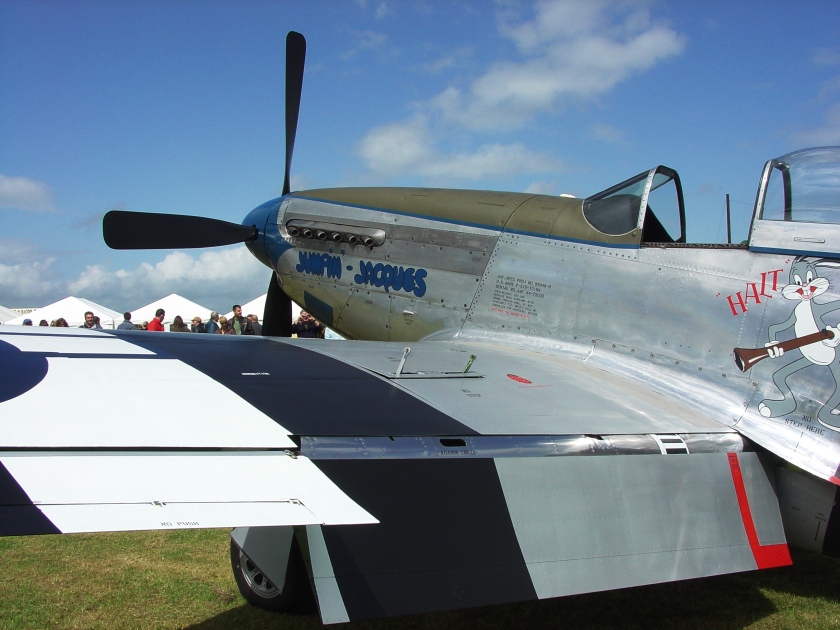Invasion stripes – a P-51 in warpaint
By: shortfinals
Tags: 'friendly fire' accidents, 'Tiffie', 160000 troops, 18 inches wide for fighters, 24 inches wide for bombers, 5000 vessels, 6th June 1944, aircraft, aircraft recognition, airpower, Allies, alternating black and white stripes, black paint, D-Day, D-Day 6th June, Defence of the Reich, Eastern Front, English Channel, Essex, Europe, every gallon of white paint available, fighter aircraft, fighter wings, France, friendly fire, FW190, German, glider tugs, Great Britain, Great Vintage Flying Weekend, Halifax, Handley Page, Hangar 11, hostile shore, Hullavington, identification markings, invasion area, invasion fleet, invasion of Europe, invasion stripes, Korean War, lower wing surface, Luftwaffe, Luftwaffe fighter wings, Me109, Mustang, Normandy, Normandy beaches, North Weald, nose art, overwhelming airpower, P-38, P-38 Lightning, P-51, P-51D, Peter Teichman, RAF, Reich Defence, Royal Air Force, Second World War, Short Stirling, single-engined aircraft, special identification markings, Suez Campaign, supply drops, support aircraft, tactical bomber, the Channel, transport aircraft, twin-engined aircraft, twin-tailed P-38 Lightning, Typhoon, upper wing surface, World War Two, WW2
Category: aircraft, Aviation, British Isles, England, Great Britain, Great Vintage Flying Weekend, military, RAF, Royal Air Force, Second World War, warbird
| Aperture: | f/8 |
|---|---|
| Focal Length: | 7mm |
| ISO: | 100 |
| Shutter: | 1/0 sec |
| Camera: | MVC-CD500 |
Invasion stripes, P-51D
D-Day, 6th June 1944. Europe woke to a new reality; the Allies had launched the largest invasion onto a hostile shore that the world had ever seen. Nearly 5,000 vessels, and in excess of 160,000 troops crossed the Channel, and hit the Normandy beaches. There are many reasons for the eventual success of the invasion, but one significant component was the application of overwhelming air power. The Luftwaffe in France was reduced to a shadow of its former self, with the demands of Reich Defence and the Eastern Front soaking away the fighter wings of FW190 and Me109s. On the 3rd June orders were issued to transport, tactical bomber, fighter and support aircraft units which would be overhead the invasion area to apply a series of alternating black and white stripes on upper and lower wing surfaces and around the fuselage. Unfortunately, because of the late notification, many of the units could only paint these bands roughly (unlike the neat stripes you see on this P-51D; they should be 18 inches wide for fighters, 24 inches for bombers). The idea was to prevent ‘friendly fire’ accidents. Although it is said that these stripes did not appear on other than single and twin-engined aircraft, this is incorrect. Both Short Stirling and Handley Page Halifax aircraft, when used as glider tugs, and making supply drops, were seen carrying invasion stripes. Earlier use of special identification markings had been made, prior to D-Day, in the case of Mustangs of the Royal Air Force and Typhoons (the ‘Tiffies’ had a special problem, as they were being confused with FW190s), but this was the largest recognition scheme to date.
It was acknowledged that the standard of aircraft recognition amongst the gunners on the invasion fleet, and with the land armies, left a lot to be desired, hence the need for ‘invasion stripes’; but even although the Allies used the unique twin-tailed P-38 Lightning, with its distinctive shape, for close escort of the fleet, they were STILL shot at!
This was not the last use of ‘invasion stripes’; they re-appeared during the Suez Campaign (yellow/black) and in the Korean War (black/white).
This beautiful P-51D is out of the North Weald ‘Hangar 11’ collection, and was flown into GVFWE by Peter Teichman.
Oh, and one last thing, it is alleged that the painting of ALL the aircraft involved took EVERY gallon of white paint available in Great Britain on the day! (Less black paint was needed, of course).
This month’s offerings!
Useful links
- Courtesy Aircraft Courtesy Aircraft are a purveyor of fine, used warbirds and other aircraft
- DONATE to the The People's Mosquito DONATE to help The People’s Mosquito Ltd build a Mosquito!
- Passiondesavions Excellent blog from a pilot and Air Traffic Controller (en francais). The photography is exceptional. C’est magnifique!
- The Mighty Jingles A truly amazing wargaming channel; aircraft (War Thunder) as well as tanks (World of Tanks)
- The People's Mosquito Ltd Help to launch a de Havilland Mosquito into British skies! An aviation charity with just one aim….
- TPM Fund Help us build a Mosqutio for Britain!
- Travelforaircraft An excellent aircraft miscellany!


Leave a comment